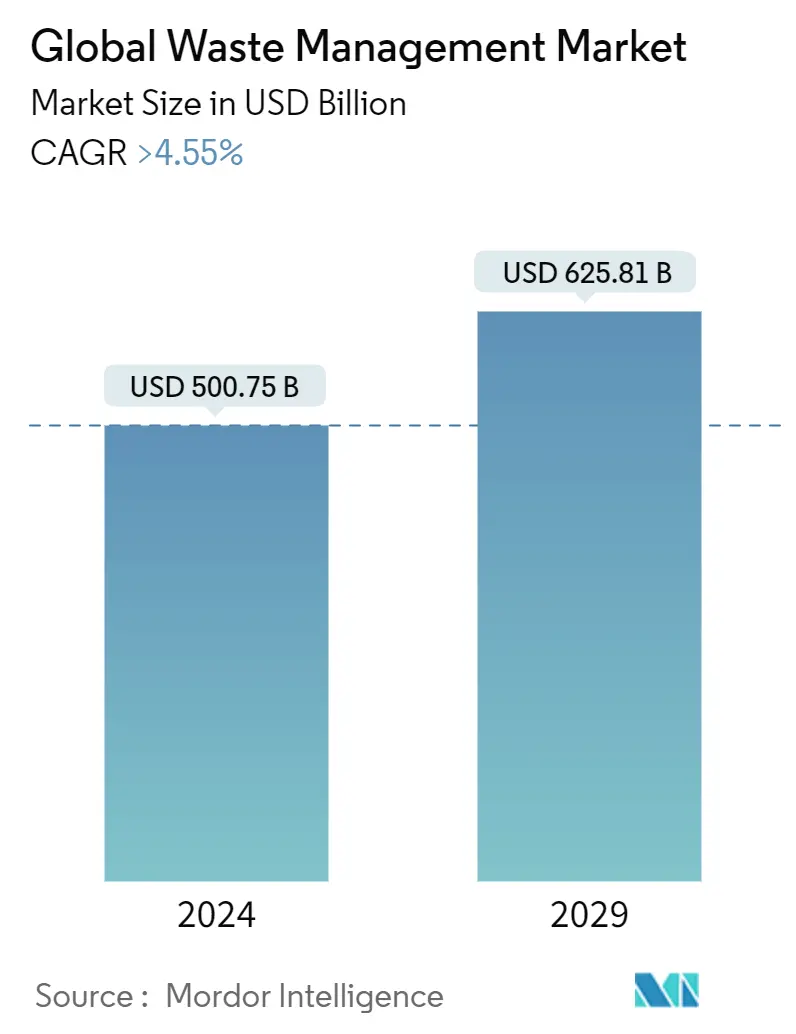Market Size of Global Waste Management Industry

| Study Period | 2020 - 2029 |
| Market Size (2024) | USD 500.75 Billion |
| Market Size (2029) | USD 625.81 Billion |
| CAGR (2024 - 2029) | > 4.55 % |
| Fastest Growing Market | Asia Pacific |
| Largest Market | North America |
| Market Concentration | Medium |
Major Players
*Disclaimer: Major Players sorted in no particular order |
Waste Management Market Analysis
The Global Waste Management Market size is estimated at USD 500.75 billion in 2024, and is expected to reach USD 625.81 billion by 2029, growing at a CAGR of greater than 4.55% during the forecast period (2024-2029).
Several key factors have led to the growth of the waste management market. First, the volume of waste produced has increased, and an effective waste management system is needed to cope with growing urbanization and population growth. The increased production of solid waste is due to the increase in consumption patterns and urban lifestyles, which makes it necessary to find innovative solutions for its efficient management.
Second, there has been an increased demand for good waste management practices due to growing awareness about the need to protect the environment and sustainability. Consumers, industry, and governments recognize the importance of reducing waste and adopting recycling and circular economy approaches to reduce their environmental footprint.
Over 2 billion tonnes of municipal solid waste are produced worldwide every year, and this figure is projected to grow by approximately 70 % until 2050. Over 10,000 tonnes of waste per day were transported to the world's most giant landfills in 2022. In addition, especially in emerging countries, waste is frequently dumped at dangerous closed landfills. There is still much room for improvement and development, given that recycling rates vary widely from country to country.
Furthermore, the development of chemical, oil & gas, automotive, and medical sectors that produce vast amounts of waste and cause pollution is due to increased industrial production in developing countries like India, China or Taiwan.
Waste Management Industry Segmentation
The Waste Management (or waste disposal) market includes the activities and actions required to manage waste from its inception to its final disposal. This consists of the collection, transport, treatment, and disposal of waste and monitoring and regulation of the waste management process.
The global waste management report offers a complete background analysis of the Global waste management market, which includes an assessment of the economy and contribution of sectors in the economy, market overview, market size estimation for key segments, and emerging trends in the market segments, market dynamics is covered in the report. The report also covers the impact of COVID-19 on the market.
The global waste management report is segmented by waste type (industrial waste, municipal solid waste, hazardous waste, e-waste, plastic waste, bio-medical waste, and other waste types), by disposal methods (landfills, incineration, and recycling), and by geography (North America, Europe, Asia-Pacific, Middle East and Africa, and Latin America). For each segment, the market sizing and forecasts have been done based on volume (tons) and value (USD).
| By Waste type | |
| Industrial waste | |
| Municipal solid waste | |
| E-waste | |
| Plastic waste | |
| Biomedical and Other Waste Types |
| By Disposal methods | |
| Landfill | |
| Incineration | |
| Recycling |
| Geography | |||||||
| |||||||
| |||||||
| |||||||
| |||||||
|
Global Waste Management Market Size Summary
The global waste management market is poised for significant growth, driven by factors such as rapid urbanization, increasing population, and the consequent rise in resource consumption and waste generation. The industry is experiencing a shift towards more sustainable practices, although challenges remain due to the lack of a comprehensive approach that encompasses the entire waste management chain, from product design to recycling. The scarcity of land for waste disposal and the emphasis on energy and resource recovery are key drivers of market expansion. However, the sector faces constraints due to lower sustainability levels and insufficient focus on waste management. The growing demand for recyclable products presents substantial opportunities for market growth, supported by proactive government measures aimed at reducing illegal dumping.
The COVID-19 pandemic temporarily altered waste generation patterns, with residential waste increasing during lockdowns as industrial and commercial activities slowed. As economies recover and production resumes, waste generation is expected to rise, revitalizing the waste management sector. The construction and demolition waste segment is particularly robust, driven by increased construction activities and the need for effective management of inert, non-biodegradable materials. This segment's growth is crucial for minimizing environmental impact and promoting sustainability. The waste management industry is highly competitive, with numerous players and startups innovating in recycling and waste reduction technologies. Strategic acquisitions, such as Biffa's purchase of Company Shop Group and Waste Management's acquisition of Advanced Disposal, highlight the industry's focus on expanding capabilities and market share.
Global Waste Management Market Size - Table of Contents
-
1. MARKET INSIGHTS and DYNAMICS
-
1.1 Market Overview
-
1.2 Insights into Technological Advancements and Innovation in Effective Waste Management
-
1.3 Value Chain/Supply Chain Analysis
-
1.4 Insights on Strategies of Rising Startups Venturing into the Global Waste Management Industry
-
1.5 Spotlight on Market Trends
-
1.6 Impact of COVID-19 on the Market
-
-
2. MARKET SEGMENTATION
-
2.1 By Waste type
-
2.1.1 Industrial waste
-
2.1.2 Municipal solid waste
-
2.1.3 E-waste
-
2.1.4 Plastic waste
-
2.1.5 Biomedical and Other Waste Types
-
-
2.2 By Disposal methods
-
2.2.1 Landfill
-
2.2.2 Incineration
-
2.2.3 Recycling
-
-
2.3 Geography
-
2.3.1 North America
-
2.3.1.1 United States
-
2.3.1.2 Canada
-
2.3.1.3 Mexico
-
-
2.3.2 Europe
-
2.3.2.1 United Kingdom
-
2.3.2.2 Germany
-
2.3.2.3 France
-
2.3.2.4 Russia
-
2.3.2.5 Rest of Europe
-
-
2.3.3 Asia-Pacific
-
2.3.3.1 China
-
2.3.3.2 Japan
-
2.3.3.3 India
-
2.3.3.4 South Korea
-
2.3.3.5 Rest of Asia-Pacific
-
-
2.3.4 Middle East & Africa
-
2.3.4.1 South Africa
-
2.3.4.2 Saudi Arabia
-
2.3.4.3 Qatar
-
2.3.4.4 Rest of Middle East and Africa
-
-
2.3.5 Latin America
-
2.3.5.1 Brazil
-
2.3.5.2 Argentina
-
2.3.5.3 Rest of Latin America
-
-
-
Global Waste Management Market Size FAQs
How big is the Global Waste Management Market?
The Global Waste Management Market size is expected to reach USD 500.75 billion in 2024 and grow at a CAGR of greater than 4.55% to reach USD 625.81 billion by 2029.
What is the current Global Waste Management Market size?
In 2024, the Global Waste Management Market size is expected to reach USD 500.75 billion.

